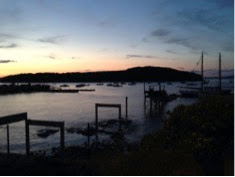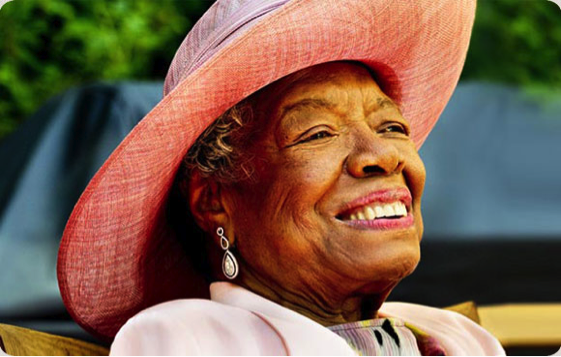Vacation on Mount Desert Island
 |
| Nina Gilden Seavey, Sunset on Bar Harbor, 2015 |
So where would we go for vacation in 2015? Various considerations set aside the old pattern of the northern Minnesota lake. My daughter Eleanor (GWU 2010) has been living for a while with her boyfriend Greg Fortier in Manhattan. Greg has always spent much of his summers in Bar Harbor, Maine, where his parents run the Bar Harbor Music Festival, so meeting the Fortiers at a well-established vacation site sounded good. Francis Fortier had founded the music festival forty-nine years ago, a pioneer bringing culture to the Maine coast. As we set out, I decided to pack my copy of Henry David Thoreau’s The Maine Woods to reread it after an interval of thirty-five years, in an effort to textualize Maine.
Bar Harbor is located on Mount Desert Island on the eastern edge of Penobscot Bay, well up the coast of Maine, reachable from Bangor. It is one of those eastern vacation spots like Currituck, Chincoteague, the Hamptons, Montauk, Nantucket, Provincetown—each a place with its own local history which has been subsumed into the experience of summer visitors.
Maine is, as a whole, necessarily anomalous, the last New England state to be admitted into the Union, as part of the Missouri Compromise, which admitted Missouri as a slave state and balanced that with what had formerly been a district of Massachusetts. A straggling collection of outport fishing villages in 1820 with a wilderness interior scarcely yet mapped, Maine had advanced from one level of political subordination to another.
So on the plane to Bangor I opened up The Maine Woods to see what I had read in 1980. One of those anomalous texts that bedevil literary scholars, it records three separate summer expeditions to Maine that Thoreau evidently intended to combine into a connected text except that he died in 1862 of tuberculosis before preparing them for publication, leaving that project to his sister and his buddy Ellery Channing, who pretty much left the versions they had without messing with them. His earliest trip, undertaken while he was still staying at Walden Pond, was to climb Mount Katahdin, the highest mountain in Maine, located way into the wilderness of northern Maine. It is especially clear from The Maine Woods that Thoreau’s distinctive accomplishment is to render the footloose rambling impulses of a young guy into literary form. He is the forerunner of Jack Kerouac, Robert Pirsig, and Hunter Thompson. Rather than sitting around with his bean crop by the pond and polishing his book manuscript for A Week on the Concord and Merrimac Rivers, he takes a steamboat trip to Bangor and canoes upstream on the Penobscot River and various northern lakes for miles and miles. Believing as he did in wildness, he seeks out the nearest wild he can find and pushes into it.
The difference between Thoreau and his footloose successors arises from his New England origins. Thoreau never felt called to preach or minister to anyone as his mentor Emerson had briefly done, but he feels even more than Emerson a need to scout out higher meanings wherever he goes. The burden of high mindedness he carries with him everywhere. Together with that disposition is his naturalist’s calling to identify the species of shrubs, trees, and animals. So he arrives at his campsite along the East Branch of Penobscot River and enumerates the undergrowth there: “I was struck by the abundance of the Linnaea borealis, checkerberry, and Chiogenes hispidula, almost everywhere in the Maine woods. The wintergreen (Chimaphila umbrellata) was still in bloom here, and Clintonia berries were abundant and ripe. This handsome plant is one of the most common in that forest.” And in the Maine woods Thoreau finds himself triangulating among three languages: Latin scientific names, familiar English terms, and the native American terms he picks up from his guides, privileging none of the three. In his later years—that is in his late thirties and early forties—as his mood darkens toward the end, he expresses to his friend Ellery Channing, “When I die, you will find swamp oak written on my heart,” a comment repeated to Emerson who enters it in his journal as evidence of Thoreau’s own consciousness of his own “stubborn contradictory attitude.” So even plants have internal meanings inherent in them. Another source of the complication in which Thoreau lived comes from his mother, one of those persnickety small town ironists so common in New England, who seems to have bequeathed to him her disposition for paradox. Emerson records in his journal an observation passed on to him from his sister-in-law, who boarded in the Thoreau house. When Mrs. Brown observed to Cynthia Thoreau that young Henry seemed to resemble Emerson in his manners, appearance, and thoughts, the mother replied, “Mr. Emerson had been a good deal with David Henry, and it was very natural should catch his ways.” Thus rather than admitting the limits of his familiar territory, he says near the beginning of his great book, “I have traveled a great deal in Concord . . .”
One evidence of the unsettled character of the Maine that he visits in the summers of 1846, 1853, and 1855 can be seen in the names he employs, working from the few Maine guidebooks and the only recently surveyed maps from a time not long following the resolution by treaty of the border between Maine and British America (Canada). So he uses various spellings for Mount Katahdin, his objective on the first trip, the highest point in the state. What draws him to Maine is its wildness, the last remaining wild region in the eastern United States, though he also registers the incursions of New England loggers, leveling some areas and venturing in particular for the white pine, which would be systematically removed even from territory scarcely accessible. He also sees his opportunity to explore the wild as not just meant for a literary record but also as an experience for the public at large, as he concludes the second journey “Chesuncook” he offers a prophetic proposal:
The kings of England formerly had their forests ‘to hold the king’s game,’ for sport or food, sometimes destroying villages to create or extend them; and I think that they were impelled by a true instinct. Why should not we, who have renounced the king’s authority have our national preserves, where no villages need be destroyed, in which the bear and panther, and some even of the hunter race, may still exist, and not be ‘civilized off the face of the earth,’—our forests, not to hold the king’s game merely, but to hold and preserve the king himself also, the lord of creation,–not for idle sort or food, but for inspiration and our own true recreation? or shall we, like villains, grub them all, poaching on our own national domains.
It would be several decades before the notion of a national park should be first applied to various western spaces, a notion inspired by disciples of Thoreau like John Muir and others. The Thoreau who paddles and portages his way into northern Maine is not the ultimately civilized abstainer from meat who appears in the “Higher Laws” essay in Walden, nor does he merely dabble at fishing. He eats salted fare that he has packed for the trip, catches fish to diversify a diet consisting of a lot of hardtack, and takes some satisfaction at the compliments on his paddling he receives from Joe Polis, his Abenaki guide. And his consumption of wildness had to include the actual flavors of Maine, so he samples drinks made of various wild roots and shrubs, comparing them to the domestic tastes of Concord or Boston.
But as Thoreau sadly realized, his encounter with Maine could only include a taste of the wild place then being improved away. Back in 1605, Samuel de Champlain, part of a French venture to establish a colony that would be called Acadie or Acadia, identified the offshore island as Mount Desert—Empty or Abandoned Mountain—located more or less midway along the coast claimed for France. But Acadia was without royal funding and its prospects depended on a Huguenot nobleman who died before being able to advance the project far, so Champlain took his colonizing ambitions further north to the prime fur trading territories near Quebec. Captain John Smith a few years later undertook a mapping and entrepreneurial expedition of the coast which he named New England, proceeding up and down the coast to designate locations usually by English names, so Penobscot Bay appears as Pembroke Bay. At this juncture it is probably impossible to speculate what if anything the local Abenakis or Micmacs called the place. Still later in the Seventeenth Century Governor John Winthrop of the Massachusetts Bay colony would cruise the coast investigating territory claimed by the English and swing past Mount Desert island noting in his journal the way “there came a smell off the shore like the smell of a garden. There came a wild pigeon into our ship and another small land bird.”
Mount Desert Island qualifies only barely as an island. The bridge connecting it to the Maine mainland scarcely extends a hundred yards in length. But it stands out from the background because various peaks rise higher than any other Northeastern high points along the coast. Late in the 1700s a little outport fishing village came to be established across from two islands, one of them called Bar Island because at low tide a substantial bar crosses from the little island creating a little protected harbor thus named Bar Harbor. In its early years it must have shared the fairly marginal existence of other little Maine outports recalled by Sarah Orne Jewett in The Country of the Pointed Firs, a copy of which I picked up in a local bookstore. But somewhere in the 1840s Mount Desert Island came to the attention first of artists like Thomas Cole and Fitz Hugh Lane, who found in the island a combination of light, sea, and rocky outcroppings to put on canvas. The eventual result would be attention from Bostonians in search of a perhaps attenuated version of the wild and remote that Thoreau had actually found.
Sarah Orne Jewett herself managed to become a healthy successor to Thoreau, born and raised in southern Maine from seagoing stock on her paternal grandfather’s side. Like Thoreau her allegiances were divided between Massachusetts and Maine. As Thoreau had to return home to Concord from his excursions in Maine, Jewett came eventually to divide her time between South Berwick and Boston. Both of them display a preoccupation with Maine shrubbery, Thoreau to document its presence, and in her stories Jewett’s local informant is the herbwoman Almira Todd, who collects her herbs for medicinal purposes and communicates stories to the narrator, a city woman spending a long summer at Dunnet Landing and preserving its troubled and sometimes uplifting past. Among the native informants the narrator turns to is a figure suggestive of what Thoreau might have evolved into if he had not died at just short of 45—deeply read, capable, and obsessive—the elderly seafarer Captain Littlepage, who seizes the narrator with his skinny arm to pass on the story he has received of access to a realm in the far north where the souls of the dead congregate and experience a semblance of life. Like Thoreau, Jewett views the advent of bigtime New England capitalism uneasily. Maine is for both of them the site of the alternative, but she is without illusion about the human costs of that isolation that goes with women left alone to fend for themselves on an unforgiving rocky coast and men at sea hauling in the local catch. For both Jewett and Thoreau the occasional clear days might reveal something miraculous in Maine. Having climbed to the top of part of Mount Katahdin, the highest point in the state, Thoreau considers, “Aeschylus had no doubt visited such scenery as this. It was vast, Titanic, and such as man never inhabits. Some part of the beholder, even some vital part, seems to escape through the loose grating of his ribs as he ascends. He is more lone than you can imagine. There is less of substantial thought and fair understanding in him, than in the plains where men inhabit.” The narrator of The Country of the Pointed Firs climbs no higher than to the height of Green Island for her own similar experience: “there above the circle of pointed firs we could look down over all the island, and could see the ocean that circled this and a hundred other bits of island-ground, the mainland shore and all the far horizons. It gave a sudden sense of space, for nothing stopped the eye or hedged one in,–that sense of liberty in space and time which great prospects always give.”
 |
| Fitz Hugh Lane, Off Mount Desert Island, 1856 |
The great luminist painter Fitz Hugh Lane could find his own significance in the Maine light in paintings like Off Mount Desert Island done in 1856. Its proximity to the mountainous territory on Mount Desert Island would keep Bar Harbor from the grimly picturesque fate of Jewett’s Dunnet Landing where the steamship era pushed sailing people to the margins and away from their former international connections. In a late Jewett story the banker center of consciousness had steered away from Mount Desert as a place with “the imported society of that renowned watering-place,” the characterization of someone with a distinct preference for the astringent pleasures of down-east New England. It does seem to have been the case that monied people from Massachusetts with a fondness for Maine scenery had begun to transform the little fishing village into a place with touristic amenities by the 1880s. The rocky interior of the island was being bought up by wealthy people for their own elegant views. By the early twentieth century John D. Rockefeller had created carriage routes through his own estate on the island with wonderful views. But Thoreau’s idea of national parks had by then turned into reality at Yellowstone and Yosemite and various other remote western places.
One of the local memories recorded in photographs and at the time in the newspapers is the occasion when President William Howard Taft visited Bar Harbor in the summer of 1910, arriving in Bangor by train and then riding a buckboard for the trip to the coastal hamlet. At the hotel where we stayed there was a suite decorated with photos of that glorious occasion. The portly chief executive no doubt found the Maine political climate to his liking and the air healthy. Most likely Taft found the concentration of Eastern wealth in Mount Desert Island congenial, but two years later Maine would cast its electoral votes for the Democrat Wilson.
During the ensuing administration a movement began to convert the personal preserves of the plutocrats on the island to public uses, so in 1916 the first national park in the east, eventually to be called Acadia National Park was created out of donated lands, relying especially on donations from Charles W. Eliot, former President of Harvard, and Rockefeller.
It is still possible to view sailboats from the heights of Mount Desert Island as in the nineteenth century, but the lobster fishery has long relied on engine power to set and hoist lobster traps. The status of the lobster in American cuisine has changed considerably since the times of Jewett’s stories, whose passing references to lobster reflect its modest standing in the Maine economy, compared for example to cod or mackerel. In the nineteenth century the ordinary lobster was seen as appropriate fare for convicts, though perhaps an unnecessary aggravation of their penal suffering. Refrigeration would alter the standing of the lobster as former New Englanders migrating to more lucrative prospects in the Midwest could experience the remembered lobster far from its home waters. Eventually the lobster would rise to its present elevated place, even appearing as evidence of Woody Allen’s squeamish incapacity in Annie Hall. Lobster and other sea food are one of the delicacies of Bar Harbor.
 |
| Eleanor Seavey, Sailing off Mount Desert Island, 2015 |
For me along with the opportunity to reread Thoreau and Jewett together with the brisk hike to the locale of the Bar Harbor Music Festival, the vacation offered a renewal of a long delayed diversion, salt water sailing. A family friend of Greg Fortier owns a forty foot sloop and took Eleanor, Greg, and me out on it. So I had a chance to beat to windward on Frenchman Bay and around to the edge of the harbor. The boat’s owner mentioned to me as we were sailing along that my surname, uncommon in most places, appears with some frequency in Maine and New Hampshire. So I explained that a seventeenth-century ancestor with my name had relocated from Devonshire to some very unpromising islands off the coast of New Hampshire, the Isles of Shoals, so that descendants of his could be found in neighboring New Hampshire and Maine.
 |
| Greg Fortier, Eleanor at the Helm, 2015 |
Apparently Seavey Island located in the harbor of Kittery, Maine, and Portsmouth, N. H., has been contested territory between the two states for some centuries. There is some appropriateness to giving one’s name to contested territory. So there must have been some recidivist aspect to this return to Maine for Eleanor and me.
Ormond Seavey









